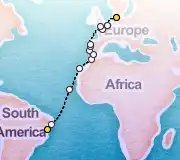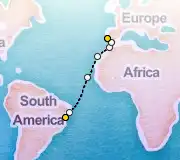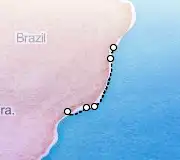The Port of Salvador, located on the shore of the vast Bay of All Saints (Baía de Todos os Santos), is a key port in northeastern Brazil. It serves as both a major commercial hub and a popular port of call for cruise ships navigating the South American coast.
The port features a modern and dedicated passenger terminal, the Terminal Marítimo de Passageiros do Porto de Salvador, situated conveniently near the city's most famous historic sites. Its strategic position offers cruise passengers immediate access to the rich cultural tapestry of Salvador, Brazil's first colonial capital.
The most prominent attraction is the Pelourinho, the city's historic heart and a UNESCO World Heritage site. Located in the upper city, just a short elevator ride from the port, it captivates visitors with its colorful colonial architecture, cobblestone streets, and vibrant Afro-Brazilian culture.
Connecting the lower and upper cities is the iconic Elevador Lacerda. This Art Deco elevator is not just a mode of transport but an attraction in itself, offering panoramic views of the bay. At its base, you'll find the Mercado Modelo, a bustling market perfect for souvenir shopping.
A short taxi ride away is the Farol da Barra, or Barra Lighthouse. Situated within the Forte de Santo Antônio da Barra, it marks the entrance to the Bay of All Saints and houses an excellent nautical museum, providing insight into the region's maritime history.
Last updated on June 24, 2025
A popular day trip is to Praia do Forte, located approximately 80 kilometers (50 miles) north of Salvador. The journey takes about 1.5 to 2 hours by car. This coastal village is famous for its beautiful beaches and the TAMAR Project, a crucial sea turtle conservation program.
Another option is a visit to Itaparica Island, the largest island in the Bay of All Saints. A public ferry from Salvador reaches the island in about one hour. It offers a more tranquil atmosphere with colonial-era towns and pleasant beaches, providing a relaxing escape from the city's hustle.
Last updated on June 24, 2025
The Port of Salvador's cruise terminal, Terminal Marítimo de Passageiros, is conveniently located in the lower city (Cidade Baixa). It sits at the foot of the steep hill that leads to the historic city center, the Pelourinho.
The distance to the main attractions in the upper city (Cidade Alta) is very short, but the incline is significant. Cruise passengers typically use the nearby Lacerda Elevator or take a short taxi ride to ascend to the historic district. The area immediately surrounding the port includes the Mercado Modelo market, but most amenities are found in the upper city. Ships almost always dock directly at the pier, making tendering a rare occurrence.
Last updated on June 24, 2025
The official currency is the Brazilian Real (BRL). While some tourist-oriented shops may accept US Dollars, it is not common practice, and the exchange rate will not be favorable.
It is highly recommended to use the local currency for all transactions. ATMs are widely available, including at the port terminal, in banks, and shopping malls. For safety, prefer using ATMs located inside secure buildings. Credit cards are widely accepted in most restaurants, hotels, and established stores, but it's wise to carry some cash for small purchases, taxis, and market stalls.
Last updated on June 24, 2025
While exploring Salvador, it is important to remain vigilant and aware of your surroundings. Like in many large cities, petty crime such as pickpocketing can occur, especially in crowded tourist areas like the Pelourinho, at markets, and during festivals.
Visitors should avoid displaying expensive jewelry, cameras, or large amounts of cash. It is generally recommended to stick to well-trodden tourist zones and avoid wandering into unfamiliar neighborhoods, particularly after dark. Using official taxis or reputable ride-sharing apps is a safer alternative to walking long distances at night. While independent exploration of the main sights is common during the day, many travelers opt for guided tours for an added layer of security and local insight.
Last updated on June 24, 2025
Salvador features a tropical rainforest climate, characterized by hot and humid conditions throughout the year. The main South American cruise season, from November to April, aligns with Salvador's summer.
During this period, daily high temperatures typically range from 26°C to 32°C (79°F to 90°F). This is also the rainiest season, though rainfall often comes in the form of short, intense tropical downpours that are quickly followed by sunshine. Visitors should pack light, breathable clothing, sun protection like hats and high-SPF sunscreen, and a small umbrella or light raincoat for the sudden showers. Unlike the Caribbean, the South Atlantic does not experience a hurricane season.
Last updated on June 24, 2025
From the cruise terminal, many key attractions in the historic upper city are accessible via the famous Lacerda Elevator, which is a short walk from where ships dock.
For destinations further afield, such as the Barra Lighthouse or popular beaches, taxis are a readily available and convenient option. It is advisable to use official, registered taxis and either agree on a price beforehand or ensure the meter is used. App-based ride-sharing services also operate in Salvador and are a popular alternative. The public bus system is extensive but can be challenging for visitors to navigate without knowledge of Portuguese.
Last updated on June 24, 2025
The primary shopping destination for cruise passengers is the Mercado Modelo, a large, historic market located a short walk from the cruise terminal. Here you can find a vast array of local handicrafts, including lacework, wood carvings, leather goods, and colorful Bahian clothing.
The streets of the Pelourinho historic district are also lined with numerous artisan shops, art galleries, and boutiques selling unique souvenirs. Local specialties to look for include berimbau musical instruments, items related to the Candomblé religion, and bottles of cachaça. Haggling is common and expected in the market and with street vendors, but prices are generally fixed in formal stores.
Last updated on June 24, 2025






No ships scheduled in port today.
Last updated on June 13, 2025
Taxis or ride-sharing apps are the most convenient ways to reach attractions from the cruise terminal; the historic Pelourinho district can be a steep uphill walk or a short taxi ride away.
The must-see attractions include the UNESCO World Heritage Pelourinho historic center, the iconic Elevador Lacerda for panoramic views, and the bustling Mercado Modelo for local crafts.
Try authentic Bahian street food like Acarajé (fried black-eyed pea fritters) or enjoy a Moqueca (seafood stew) at restaurants in Pelourinho or near the Mercado Modelo.
The local currency is Brazilian Real (1 USD = 5.54 BRL). ATMs are widely available near the port, in the Pelourinho district, and in shopping areas for withdrawing Brazilian Real. Currency exchange houses (casas de câmbio) are also found in tourist zones.
Salvador typically has warm and humid tropical weather when cruises visit. Pack light, breathable clothing, sunscreen, a hat, and a light raincoat as showers are common.
Porto da Barra beach is a popular and relatively close option, easily accessible by a short taxi ride. Farol da Barra, near the famous lighthouse, is another excellent choice.
Cruise line excursions often cover the main city highlights like Pelourinho. For more flexibility or specialized tours, consider reputable independent operators booked in advance.
The Mercado Modelo near the port is ideal for handicrafts, lacework, musical instruments like the berimbau, and art. Bahian clothing and local cachaça also make great souvenirs.
Within Salvador, consider visiting the impressive São Francisco Church and Convent or exploring the Barra neighborhood with its lighthouse and beaches, all reachable by taxi for a day visit.
Salvador was Brazil's first capital city, from 1549 to 1763, and is renowned as the heart of Afro-Brazilian culture.
Overall cruises from Salvador are fairly inexpensive compared to other ports. Check the illustration below for the average cost per day by month. Prices are around equal throughout the year.
Want to hear about the best deals and cruise tips every week? Sign up for our free weekly VIP Newsletter, customized exactly to your preferences!